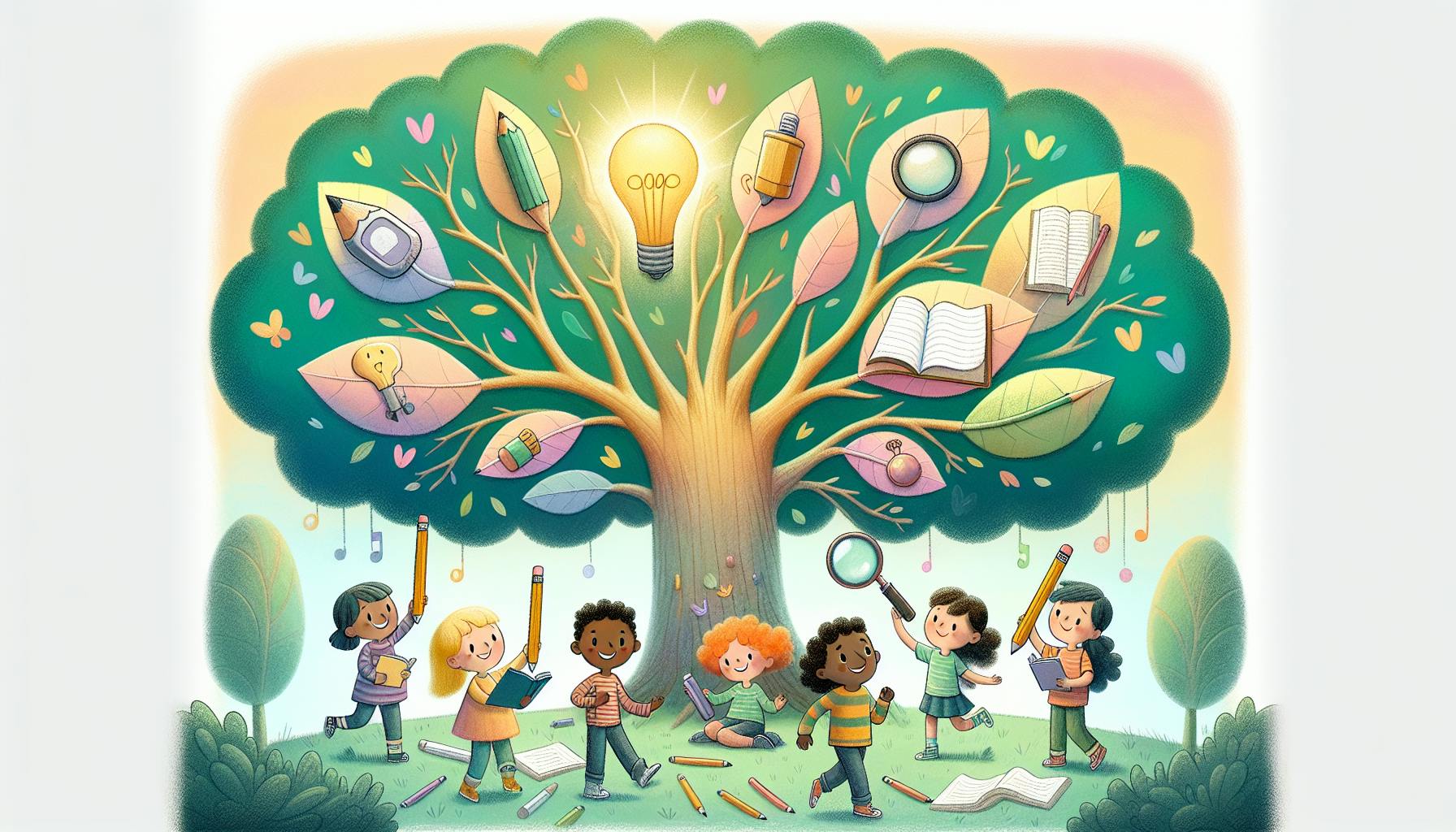Most teachers would agree that keeping students engaged and attentive throughout the school day can be challenging.
Using short brain breaks between lessons can help maximize student attention, comprehension, and retention.
In this article, we'll explore the science behind brain breaks, provide examples and specific strategies for different age groups, give ideas to integrate them into academic content, and summarize the benefits for learning.
Harnessing the Power of Brain Breaks
Brain breaks are short, intentional pauses taken during lessons or activities that allow students to refresh their minds and bodies. Incorporating brain breaks into the school day provides cognitive and physiological benefits that support student learning. This article explores what brain breaks are, why they matter for attention and learning, and how teachers can effectively implement them in their classrooms.
Defining Brain Breaks and Their Role in Education
Brain breaks, sometimes called energizers or re-focus breaks, are quick activities or movements done in the classroom to give students' brains and bodies an opportunity to refresh. Common brain break activities include:
- Stretch breaks
- Breathing exercises
- Short physical activities (dancing, jumping jacks)
- Mindfulness practices
- Humorous videos or jokes
Brain breaks help students maintain focus and attention, while also promoting movement and activity. They give the brain a chance to rest and solidify new information absorbed during lessons. Even short 1-3 minute breaks have been found beneficial. Teachers can implement them throughout the day, especially during lengthy academic blocks when students' attention is most likely to lag.
Exploring the Cognitive Science Supporting Brain Breaks
Cognitive and learning sciences have demonstrated how brain breaks support student achievement. Key mechanisms include:
- Reactivating blood flow: Movement increases blood flow and oxygen to the brain, "reactivating" mental resources.
- Allowing diffuse thinking: Breaks enable the brain to process new information absorbed during focused learning activities.
- Releasing neurotransmitters: Physical activity promotes chemicals like dopamine and serotonin that enhance mood, motivation, and memory consolidation.
By leveraging these cognitive processes, brain breaks prepare students' brains for further learning. Teachers can strategically implement them before introducing complex new material.
Brain Breaks as a Classroom Management Tool
Brain breaks give students a structured outlet for movement and noise within the classroom environment. As such, they can minimize off-task behaviors and serve as an effective classroom management technique. Teachers can use brain breaks:
- As a reward or incentive for positive student behaviors
- To refocus student attention during lengthy classes
- To manage transitions between activities
- To release pent-up energy and stimulate productivity
Establishing brain break routines helps students understand expectations around appropriate movement and noise. The breaks can then facilitate - rather than hinder - efficient classroom functioning.
Practical Implementation of Brain Breaks for Enhanced Student Engagement
When planning brain breaks, teachers should consider timing, variety and age appropriateness. Example strategies include:
- Start and end class with quick 1-2 minute movement routines
- Use brain break videos with clear start and stop signals
- Create a classroom "energizer wall" with student input on activities
- Modify activities based on grade level (e.g. incorporating academic content review for older students)
- Set expectations and rules around volume and participation
Integrating just a few short brain breaks per day can make a tremendous difference in keeping students focused and engaged in learning. These breaks allow their minds and bodies to take a temporary yet vital reprieve, enabling fuller attention and retention of classroom material and instruction.
What is a brain break and examples?
Brain breaks are short breaks taken during lessons to re-energize students and improve focus and retention. They provide a mental and physical reset to maximize attention span and learning.
Here are some examples of effective brain break activities:
Movement-Based Activities
- Simon Says - Students follow the teacher's commands for different movements. This gets students out of their seats for a few minutes of activity.
- The Wiggles - Students stand up and wiggle different body parts to a fun song. Shaking arms and legs helps students burn excess energy.
- Head, Shoulders, Knees, and Toes - Students touch different body parts in sequence, singing along to the song. Coordinating movements crosses left-right brain hemispheres.
Mindfulness Practices
- Breathing Exercises - Students participate in deep breathing, visualization, and meditation for 1-2 minutes to relieve stress.
- Gratitude Sharing - Students take turns sharing things they feel grateful for. This uplifts mood and classroom culture.
- Calm Music - Playing relaxing music gives students' brains a break from academic content.
Sensory Activities
- Light Stretches - Gentle stretches release tension in students' muscles and improve circulation.
- Fidget Toys - Students manipulate stress balls, spinners, etc. for a sensory outlet to refocus.
Brain breaks can be done multiple times per day. Even quick 60-second breaks have benefits! Consistency is key to keep students' brains refreshed.
What is the 5 4 3 2 1 brain break?
The 5 4 3 2 1 brain break is a simple yet effective classroom strategy to re-energize students. As the name suggests, it involves leading students through a series of 5 different movements, then 4, then 3, then 2, and finally 1.
Here is an example sequence:
- 5 jumping jacks
- 4 high knees
- 3 arm circles
- 2 squats
- 1 deep breath
Or another fun sequence could be:
- 5 silly dances
- 4 jumping jacks
- 3 funny faces
- 2 high fives with a friend
- 1 loud cheer
The key is to pick engaging movements that get students moving and laughing. This quick physical and mental break allows students to refocus their attention and motivation.
Some benefits of the 5 4 3 2 1 brain break include:
- Improved focus and concentration when students return to academics
- An outlet for pent-up energy
- Increased oxygen flow to the brain
- Fosters classroom community and collaboration
- Sets a positive mood
Brain breaks are short bursts of physical activity inserted at strategic times during lessons. Studies show incorporating regular brain breaks, even for just 5-10 minutes, can vastly improve educational outcomes. The 5 4 3 2 1 brain break is an easy go-to brain break strategy for teachers to try. Simply lead students through the sequence, encouraging fun and active participation. Students will return to their seats re-energized and ready to refocus.
What is the theory behind brain breaks?
Brain breaks are short breaks taken during lessons or between learning activities. They allow students' brains to reset and restore the ability to focus.
The theory behind brain breaks is based on findings from neuroscience research:
- The brain's pathways that are used heavily during learning activities become fatigued after sustained use. This leads to reduced attention, comprehension, and memory retention.
- By briefly switching students' focus to a different type of activity, the resting pathways can reactivate. This restores students' ability to concentrate, absorb new information, and form long-term memories.
- Information passes through the emotional filters in the brain before it can be stored as memory. Brain breaks that incorporate movement, humor, games, or relaxation can stimulate production of neurotransmitters that improve mood, motivation, and memory encoding.
In essence, well-timed brain breaks maximize the brain's capacity to learn by allowing its pathways to take turns being in a state of focused activity versus restorative rest. Strategically alternating learning modes prevents cognitive overload.
Teachers can leverage this to design lessons that optimize student engagement, comprehension, and knowledge retention.
sbb-itb-bb2be89
Why do high school students need brain breaks?
High school students face immense academic pressure and packed schedules. Brain breaks provide a crucial mental and emotional reset during the school day.
Preventing Burnout
The teenage brain is still developing impulse control and emotional regulation. Without regular breaks, students can easily become overwhelmed by assignments, tests, projects, extracurriculars and more. Short brain break activities create space for students to decompress before frustration boils over.
Brain breaks also give students a chance to socialize and connect with peers, which is vital for mental health. Simple 5-minute dance sessions or laughter yoga can lift moods and strengthen relationships.
Optimizing the Learning Process
Frequent brain breaks align with the science of learning and memory. The brain absorbs new information best in short, focused bursts. Breaks prevent cognitive overload so students return to course material feeling energized and engaged.
Brief exercises also increase blood flow and oxygen to the brain, stimulating neural networks critical for concentration, memory, and problem-solving. Whether it's a quick round of Headbanz or a mindful breathing exercise, brain breaks enhance academic performance.
Fostering Well-Being
Daily doses of joy and play aren’t frivolous. They help high schoolers lead balanced, fulfilling lives even amidst heavy workloads. Brain breaks teach students healthy stress coping strategies they can carry into adulthood.
Laughter and activity also strengthen relationships between classmates and teachers, cultivating an inclusive, supportive learning community.
Brain Break Strategies for Different Age Groups
Effective brain break activities differ based on students' developmental needs. Younger students benefit more from physical movements, while older students need more mental breaks.
Kindergarten Brain Breaks: Fostering Movement and Imagination
Kindergarteners have lots of energy and short attention spans. Brain breaks for this age should get them up and moving while also stimulating their creativity. Some ideas include:
- Simon Says
- Freeze Dance
- Imaginary adventures ("Let's go to the moon!" or "We're exploring the jungle!")
- Short yoga flows
Keeping brain breaks lively, physical, silly, and fun is key for engaging young kindergarten students.
Elementary Brain Break Activities: Engaging Young Minds
As students progress through elementary school, finding new ways to capture their attention is important. Great brain break activities for grades 1-5 include:
- Charades
- GoNoodle videos
- Brief physical challenges (10 jumping jacks, run in place for 30 seconds)
- Jokes and riddles
Brain breaks for elementary school kids should vary in length and type, mixing movement with imagination, laughter, and surprise.
Middle School Brain Breaks: Balancing Energy and Focus
The middle school years come with increased demands for focus and learning more complex concepts. But lots of energy still needs an outlet. Effective brain breaks for middle schoolers include:
- Allowing students to choose their own music or safe YouTube videos to watch and dance along with
- Providing a menu of brain break options like mad libs, coloring, journaling, meditation apps, or group games
- Structured physical activities like wall sits or planks
Giving middle school students more autonomy over brain breaks can make them more effective while teaching self-regulation.
High School Brain Breaks: Encouraging Independence and Relaxation
By high school, students' brains are still developing impulse control and executive function. Brain breaks for teens should help counter mental fatigue. Ideas include:
- Sudoku or crosswords
- Calming nature videos
- Breathing exercises
- Allowing short walks around campus
- Providing fidget toys
The goal of brain breaks for high schoolers should be supporting mental relaxation, rather than stimulating more energy.
Brain Breaks for College Students: Promoting Self-Regulation and Mental Health
College poses new academic challenges, along with general life stressors. Brain breaks for college students should address both cognition and mood regulation. Strategies include:
- Short meditations
- Snack and stretch breaks
- Looking out windows at greenery
- Doodling or journaling
- Self-affirmation exercises
Building self-awareness around needing breaks, and allowing students to choose activities aligned with their needs, makes brain breaks more beneficial for adult learners.
Brain Break Ideas: From GoNoodle to Mindfulness
Taking breaks during class allows students to refocus their attention and recharge their minds. Implementing creative and engaging brain break ideas is an excellent way for teachers to enhance learning outcomes. There are many easy-to-implement options, from energetic GoNoodle videos to mindfulness cards that promote self-regulation skills.
GoNoodle Brain Breaks: Interactive and Energetic
GoNoodle provides short, interactive brain break videos that get students up and moving. The videos feature dancing, stretching, breathing exercises set to upbeat music. GoNoodle is designed for elementary school students but offers content for older grades too. Benefits include:
- Improves focus and learning retention
- Provides physical activity breaks
- Promotes classroom community
- Appeals to visual, auditory, and kinesthetic learners
Teachers can create free accounts to access videos and track student progress. GoNoodle also integrates with popular classroom technology platforms.
Mindfulness Cards for Kids: Promoting Emotional Regulation
Mindfulness cards guide students through breathing techniques, sensory awareness, and reflection prompts. Practicing mindfulness teaches self-regulation, reduces stress, and improves executive functioning. Teachers can use mindfulness cards during short brain breaks. Benefits include:
- Develops emotional regulation skills
- Encourages self-reflection
- Fosters resilience and well-being
Free printable card sets are available online spanning elementary through high school. Mindfulness cards can be implemented individually, in small groups, or with the whole class.
Funny Brain Breaks: Laughter as a Learning Aid
Humorous videos and games prompt laughter, increase oxygen flow to the brain, and stimulate the release of endorphins. Funny brain breaks re-energize students and create positive associations with learning. Ideas include:
- Funny animal videos
- Silly dancing or singing
- Age-appropriate jokes and riddles
Laughter has proven cognitive benefits like improving memorization and creative problem-solving. It also encourages social bonding. However, teachers should ensure all students are comfortable with humorous content.
Printable List of Brain Breaks: Easy Access for Teachers
Compiling brain break ideas into printable handouts, posters, or slide decks allows quick classroom reference. Teachers can easily implement activities without extensive prep or supplies. Printable brain break guides include:
- List of video links
- Description of activities
- Time recommendations
- Target age ranges
- Categorization by type
Accessible brain break guides help teachers seamlessly incorporate activity breaks as needed. Customizable templates allow adaptation across grade levels and subject areas.
Brain Break Activity Cards: Spontaneity in Classroom Strategy
Brain break activity cards add spontaneity and surprise to learning environments. Teachers and students can create DIY card decks or print premade sets with prompts like:
- Stretching exercises
- Breathing techniques
- Silly dances
- Scavenger hunts
- Collaborative challenges
Students can take turns drawing cards and leading activities. Activity card brain breaks increase student ownership of classroom culture. The element of surprise captures attention while allowing movement.
Implementing regular brain breaks, whether silly or serious, is an impactful teaching strategy. Brain breaks provide mental rests, improve focus, teach self-regulation, and create positive learning environments. With many easy classroom integration ideas, teachers can readily incorporate brain break activities to maximize student attention and learning.
Integrating Brain Breaks with Academic Content
Brain breaks provide students a mental respite while reinforcing educational concepts. Strategically integrating them into lessons optimizes their benefits.
Content Area Literacy: Brain Breaks That Complement Curriculum
- Vocabulary charades - Act out vocabulary words to embody their meanings.
- Subject taboo - Describe concepts without using taboo words tied to curriculum.
- Content pictionary - Draw curriculum concepts for peers to guess. Reinforces retention.
Instructional Routines and Grouping: Optimizing Brain Breaks
Integrate brain breaks into instructional segments. Some examples:
- Turn lectures into brain break "jeopardy" games with movement upon correct answers.
- Use brain breaks as "commercials" between rotating small group stations.
- Build physical activity into transitions between whole class, small group, and individual work modes.
Evidence-Based Instruction and Multi-Tiered Support Systems (MTSS)
Brain breaks provide mental breathing room for students to process intensive interventions.
- Use as palate cleansers between intensive interventions to reboot mental focus.
- Help identify students needing more frequent brain breaks. Adjust MTSS supports accordingly.
ELA Standards and Brain Breaks: Enhancing Literacy Engagement
- Charades to act out plot events. Boosts comprehension and engagement.
- Physical reenactments of character interactions. Enhances perspective-taking.
- Vocabulary freeze dance. Improves word retention via kinesthetic learning.
Neurodiversity and Learning Differences: Tailored Brain Breaks
Accommodate needs with specialized brain break options:
- Noise-canceling headphones for sensory sensitive students.
- Verbal prompts for visually impaired learners.
- Adjust durations to match attention spans.
Careful brain break integration promotes inclusivity.
Conclusion: The Lasting Impact of Brain Breaks on Learning
Strategic brain breaks boost student attention, motivation, and learning outcomes. Keep activities short, frequent, and developmentally appropriate. Check-in with students and adjust approach accordingly. With some creativity and planning, teachers can build brain breaks into lessons to maximize student potential.
Summarizing the Benefits of Brain Breaks
Brain breaks provide students an opportunity to reset their attention and energy levels, leading to increased focus, motivation, and retention when learning new material. Even short 1-2 minute breaks can improve mood, reduce stress, and enhance academic performance if incorporated systematically. Teachers should tailor brain break style and frequency to grade level while monitoring effectiveness.
Future Directions for Brain Break Research and Practice
As research on brain breaks continues, key questions remain regarding optimal duration, timing, and activities for different age groups. More evidence on long-term impacts is needed. Regardless, brain breaks are a promising practice that allows students to self-regulate and teachers to recalibrate lessons. Continued innovation in this space will further unlock student potential.
Guidance for Families: Supporting Brain Breaks at Home
Parents can encourage mini brain breaks during homework by allowing movement or listening to music after completing sections. Break activities should match the child's needs and interests. Observe their engagement and stamina, adjusting break frequency accordingly. Communicate with teachers on effective brain break strategies.
Linking School to Home: Brain Breaks as a Bridge
Teachers can promote brain breaks through back-to-school nights, newsletters, and communication apps. Explain the research-backed benefits and provide examples of classroom brain breaks. Encourage families to try similar short sensory/movement breaks at home to reinforce this healthy habit.
Watch and Learn: Brain Breaks in Action
Before implementing classroom brain breaks, educators can learn from videos of the strategy in action. Observe timing, prompting levels, student engagement and developmental appropriateness. Brain breaks should activate multiple learning modalities while allowing students to self-regulate. When planned creatively, teachers can build academic concepts into activities.


